Past Exhibits (Selected)
2024 - 2025
ERA In the Heartland: Ratification and Reconsideration in Kansas, 1973-1980
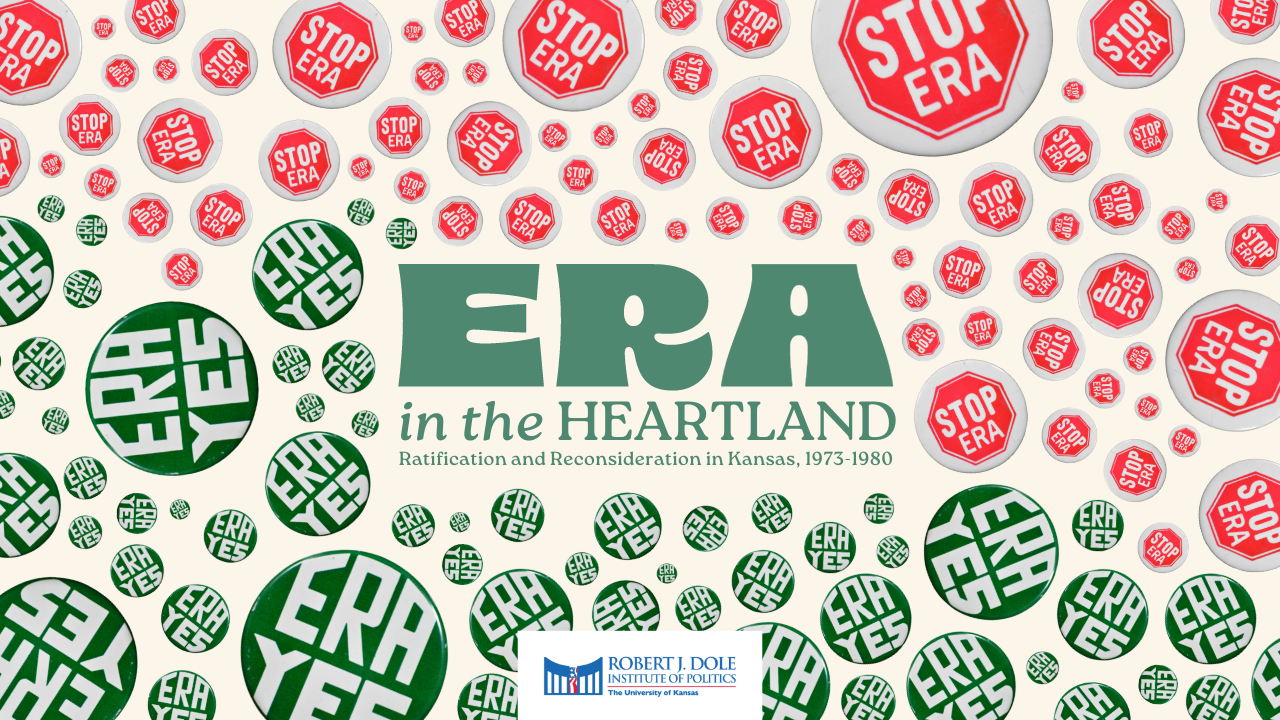
June 2024 - Mar. 2025
In the early 1970s states raced to ratify the Equal Rights Amendment after it was passed in Congress. It seemed inevitable that the legislation, granting equal rights to men and women, would become the 27th amendment to the United States Constitution. Grassroots movements – for and against the amendment – mobilized swiftly in response. Highlighting the voices of ordinary Kansans, this exhibit explores the dialogue surrounding the adoption of the ERA in our state and its legacy today.
This exhibit is based on University of Kansas history and journalism student Alexandra Haggar’s Honors thesis: “Rescind ERA: The Failed Efforts in Kansas to Rescind Ratification of the Equal Rights Amendment, 1973-1980.”
This exhibit was presented in partnership with the KU Department of History and with special thanks to Dr. Marie Grace Brown.
This exhibit featured materials from the Kenneth Spencer Research Library at the University of Kansas.
2023 - 2024
Landmarks in Leadership: Bob Dole's Legacy at 100 Years
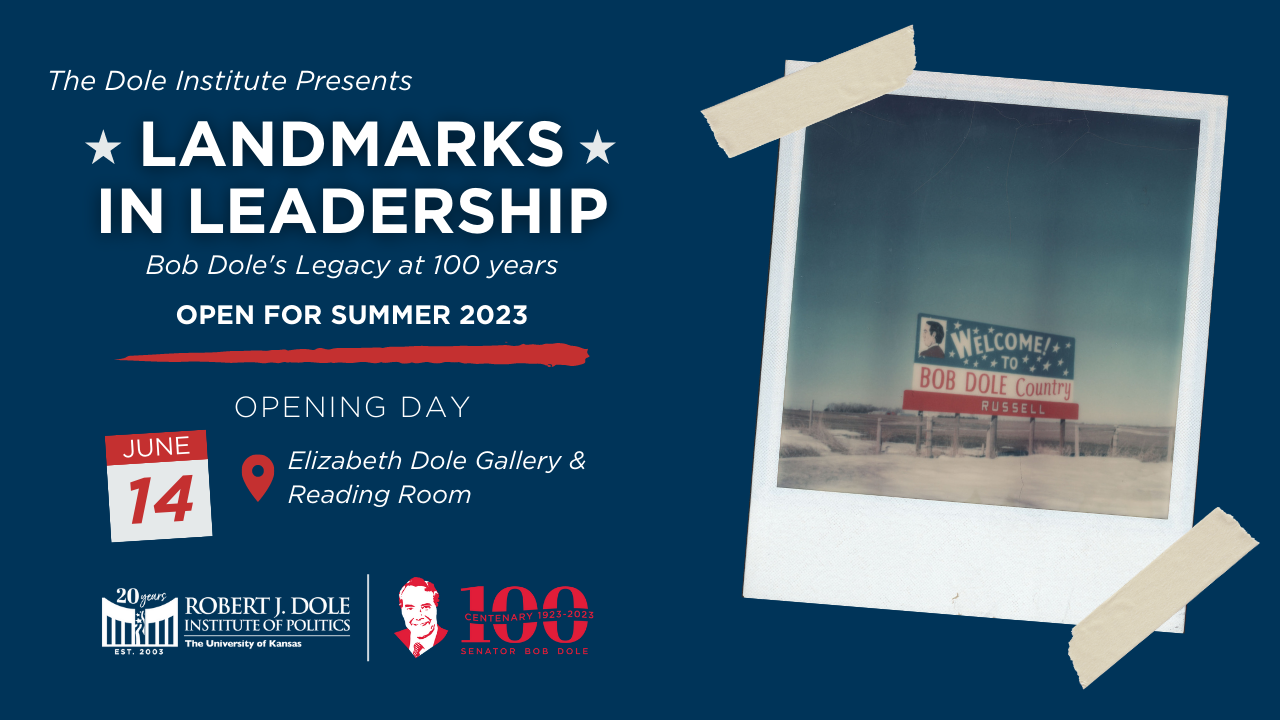
June 2023 - Mar. 2024
Senator Bob Dole’s leadership shaped Congress, our nation, and the world. See his life and legacy through your eyes by viewing our special exhibit, Landmarks in Leadership: Bob Dole’s Legacy at 100 Years.
To commemorate his 100th birthday, the Dole Archives presents never-displayed materials highlighting his landmark career. Featuring objects, manuscripts, and photographs from the Robert and Elizabeth Dole Archives and Special Collections, the exhibit tells the story of major moments in Senator Dole’s career through archival collections, such as a vintage 1968 Dole for Senate billboard, a scale model of the Dole Institute, and rocks used for the construction of the WWII Memorial in Washington, D.C.
Thank you to our Landmark Event Sponsors AARP-Kansas and Microsoft and all our season’s supporters.
2022 - 2023
Missing, Then Action: An Army Wife Speaks Out
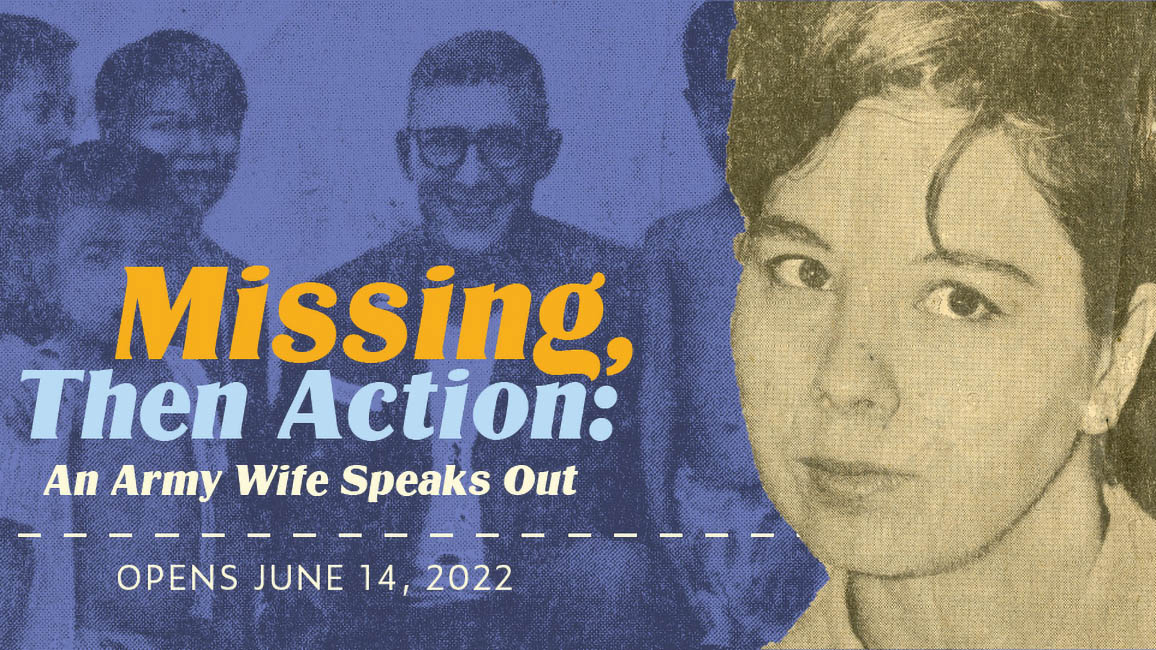
June 2022 - May 2023
In June 1965, Kansan Kathleen Johnson received word that her husband, U.S. Army Major Bruce Johnson was missing.
For four years, she waited—then, she sought answers for her three young children. This is her story of love, loss, waiting – and action.
Kathleen Johnson of Salina, Kansas was a founding member of the National League of Families of Prisoners and Missing in Southeast Asia. These brave military wives from across the country spoke out, against government policy, to seek recognition, answers, and accounting for their prisoner of war (POW) and missing in action (MIA) husbands during Vietnam. Some national leaders, including Senator Bob Dole, became fervent advocates for them in the halls of the U.S. government.
This special exhibit is made possible by ITC Great Plains.
2022
What Would a Woman Offer Her Country? Elizabeth Dole's Ground-breaking, Trail-blazing Life of Service
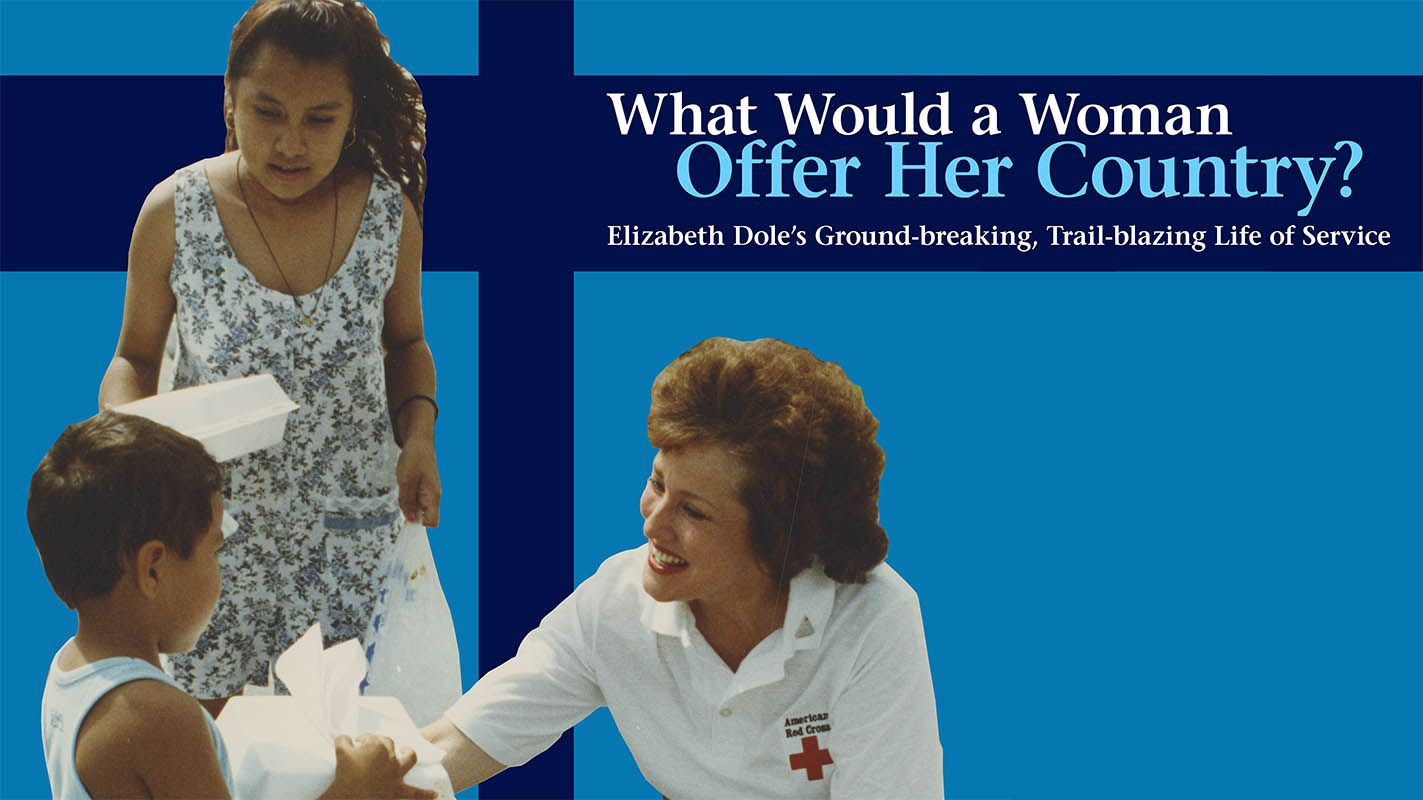
March - May 2022
Featuring items from Elizabeth Dole’s own historical collections, which she donated to the Dole Institute in 2017, the exhibit chronicles over 6 decades of people-focused leadership and policymaking.
2021
Voices from the Big First, 1961-1968
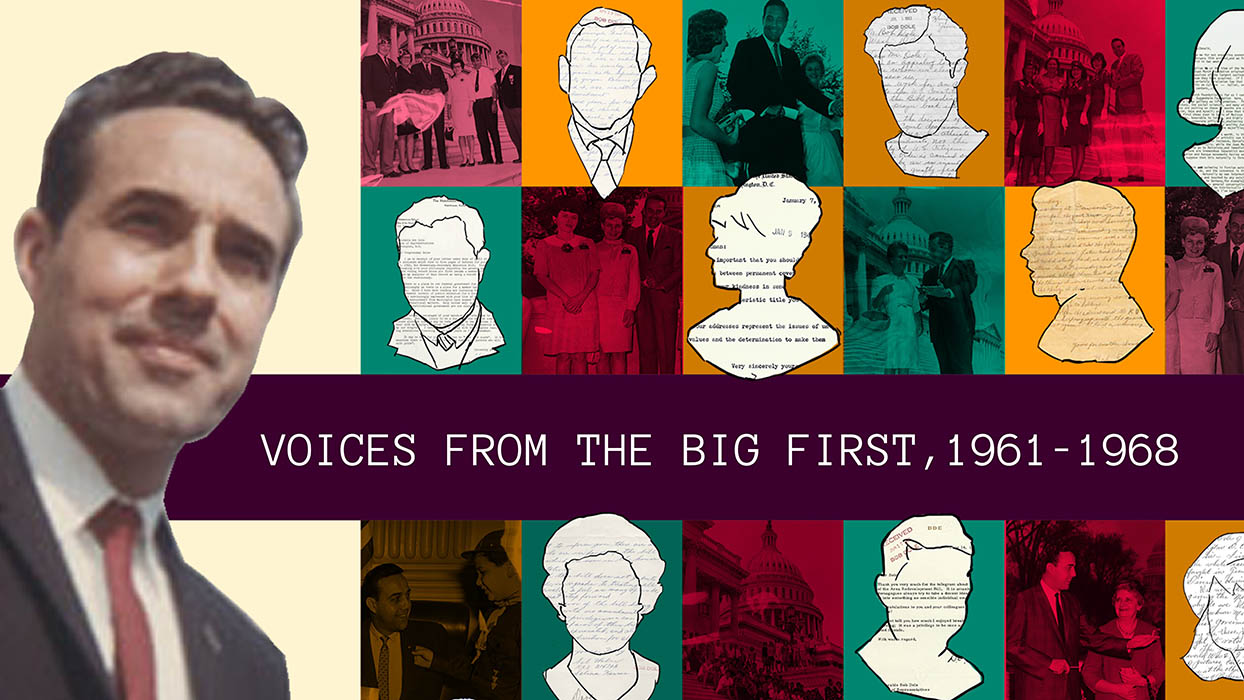
February - October 2021
In 1961, Kansas, with the rest of the United States, found itself at a political, social, and cultural crossroads. Featuring a selection of constituent letters written to then-Congressman Bob Dole from the collections of the Dole Archives, this original exhibit offers a window into the hopes and fears of everyday Kansans as they responded to change at home and conflict abroad.
Visit the companion 'Voices from the Big First, 1961-1968' digital exhibit
September 11, 2001: The Day that Changed the World
August - September 2021
The Dole Institute displayed a special poster exhibition in Simons Media Room from August 31 through September 19, on the occasion of the 20th anniversary of the September 11 attacks. Entitled “September 11, 2001: The Day that Changed the World,” the exhibit reviews the events of the day, highlights personal experiences, and invites reflection. It was developed by the 9/11 Memorial Museum with support from the National Endowment for the Humanities.
In Hansen Hall, visitors can also view two original beams from World Trade Center Tower One, a permanent memorial at the Institute. The two columns were salvaged and presented to the Dole Institute by Mayor Michael Bloomberg, in appreciation of Senator Bob Dole’s work with Former President Bill Clinton on the Families of Freedom Scholarship Fund for the children of 9/11 victims.
2019 - 2020
What Would a Woman Offer Her Country? Elizabeth Dole’s Ground-breaking, Trail-blazing Life of Service
December 2019 - May 2020
In her 1999 exploratory announcement for her presidential campaign, Senator Elizabeth Dole asked, "What would I as a woman offer our country?" The answer can be seen throughout her years of public service, where she served as the head of some of our government's most important offices, including the Department of Transportation, the Department of Labor, and the Federal Trade Commission. She also served as head of the American Red Cross, where she played an important role in the United States' efforts aid those who were impacted by disasters around the world.
Charting her over six decades of people-focused leadership and policymaking, the exhibit features over 100 items from Dole’s own historical collections, which Elizabeth Dole donated to the Dole Institute in 2017. Special emphasis is given to her time in the federal bureaucracy, while also highlighting her service to the people of North Carolina in the United States Senate, and her attempt for the presidency in 2000.
2019
Inspired by Ike

June - August 2019
Senator Bob Dole’s admiration for President Dwight D. Eisenhower shines in his historical collections at the Dole Institute. As a fellow Kansan and a soldier in World War II, Bob Dole was inspired by the leadership of his commanding officer, General Eisenhower. Years later, President Eisenhower’s messages of people and principle attracted political aspirant Dole to the Republican Party. In the decades after the President’s death, Dole lead many efforts to honor his political hero, including serving as the Chairman of the 1990 Dwight David Eisenhower Centennial Commission, and as finance chair for the Campaign for the Eisenhower Memorial.
This collection feature at the Dole Institute explores photos, historical mementos and documents from the archives that trace Dole’s lifelong admiration for Eisenhower. This feature marks the 75th anniversary of D-Day, and celebrates the re-opening of the renovated Dwight D. Eisenhower Presidential Library in Abilene, Kansas.
2017
The League of Wives: Vietnam’s POW/MIA Allies & Advocates
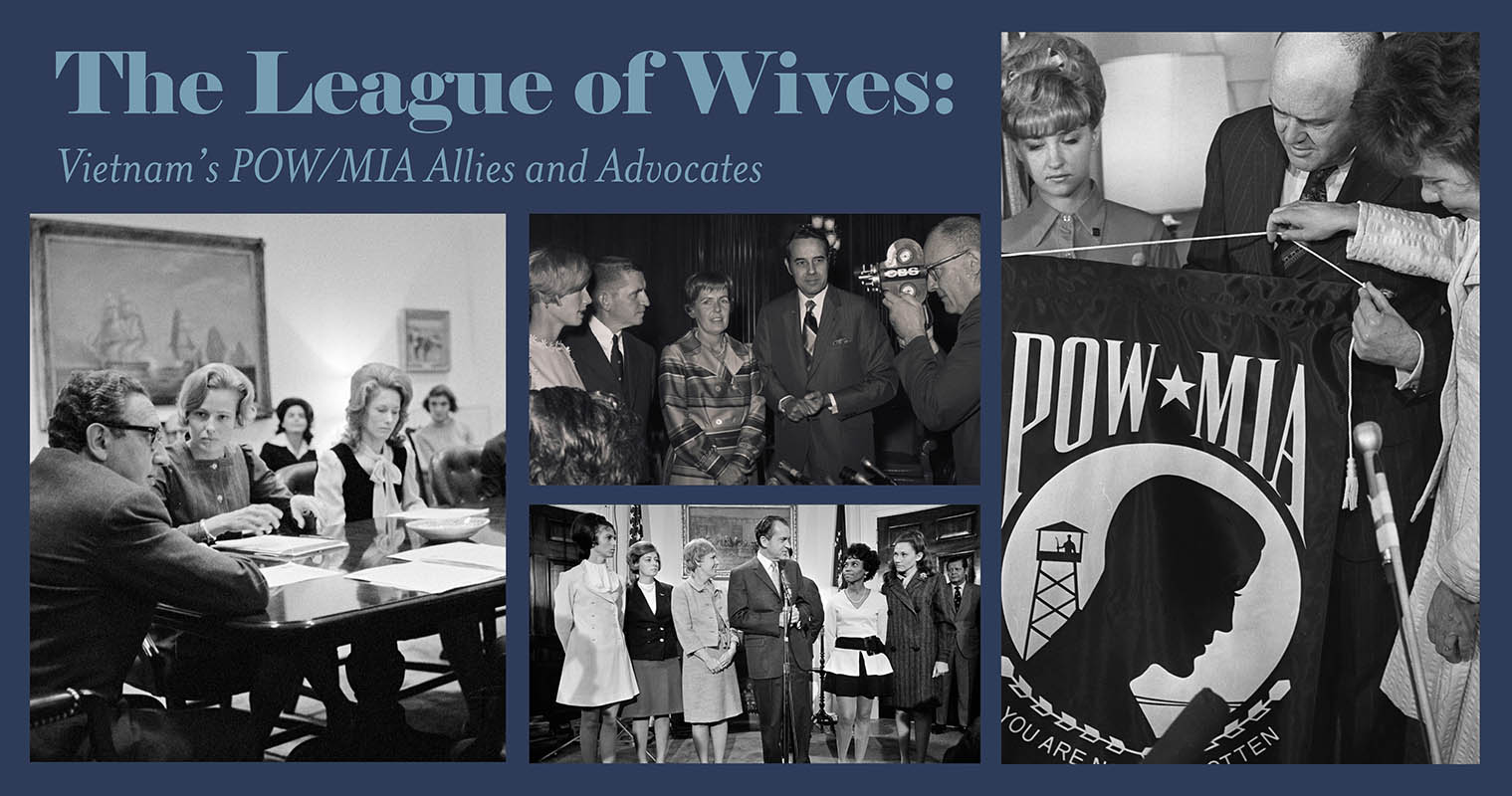
May - December 2017
In the late 1960s, POW/MIA wives bucked government protocol and challenged the traditional role of “military wife.” These courageous women led by Sybil Stockdale on the West Coast, Jane Denton, Louise Mulligan, and Phyllis Galanti on the East Coast and later Helene Knapp in the Interior West organized to form the National League of POW/MIA Families. The women worked with Congress and the Nixon administration to demand accounting for their husbands and pursue their safe return after years of imprisonment and torture by the North Vietnamese.
Curated by 2017 Dole Archives Curatorial Fellow Heath Hardage Lee, and based on her upcoming book, The League of Wives: a True Story of Survival and Rescue from the Homefront (2019, St. Martin’s Press), this special exhibition features documents, photos, oral histories and memorabilia from the Dole Archives, personal collections of POW/MIA families, and other institutions.
Programming made possible by funding from Harlan and Alice Ann Ochs, of Colorado Springs, in honor of Larry Ochs.
2016 - 2017
From State to Nation: Dole for Vice President, 1976
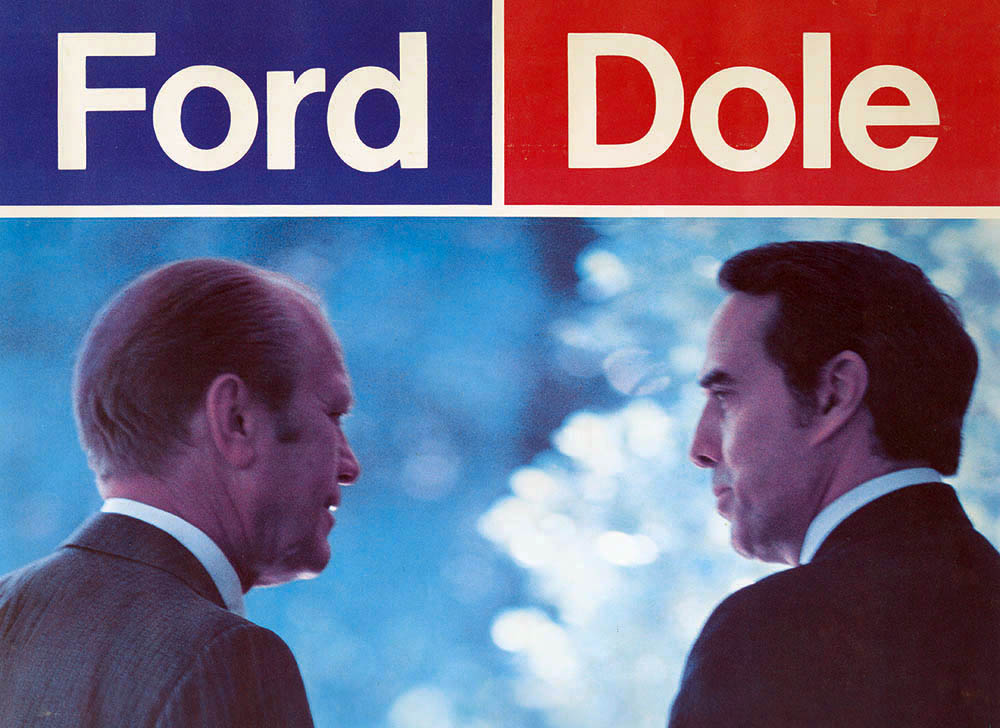
August 2016 - January 2017
The 1976 presidential campaign came to fruition under extraordinary circumstances. The nation was celebrating its 200th birthday, while also reeling from the betrayal and resignation of President Richard Nixon in the wake of the 1974 Watergate scandal. Then-Vice President Gerald Ford assumed the duties of president, and faced his first attempt to run for the presidency in 1976 - an unusual situation for a sitting president. But President Ford faced varying challenges in his candidacy, including the rise of California Governor Ronald Reagan, and the announcement that his Vice President, Nelson Rockefeller, would not join President Ford on the ballot.
The exhibit follows the path that brought Kansas' junior senator, Bob Dole, to being selected as President Ford's running mate. Dole's experience as the Chairman of the Republican National Committee and in the Senate gave proof to his loyalty to the Republican Party. These conservative credentials, along with his Midwestern appeal, skill in retail politics, and aggressive campaign style, contributed to Ford's selection of him for the Vice Presidency.
See the related oral history digital exhibit, Legacies of '76, which showcases many of the materials from the Robert and Elizabeth Dole Archives and Special Collections that relate to the Ford-Dole 1976 Campaign for President.
Audio description for this exhibit made possible by Kansas Audio-Reader Network - Made possible by the Enid and Crosby Kemper Foundation
2015 - 2016
Celebrating Opportunity for People with Disabilities: 70 Years of Dole Leadership
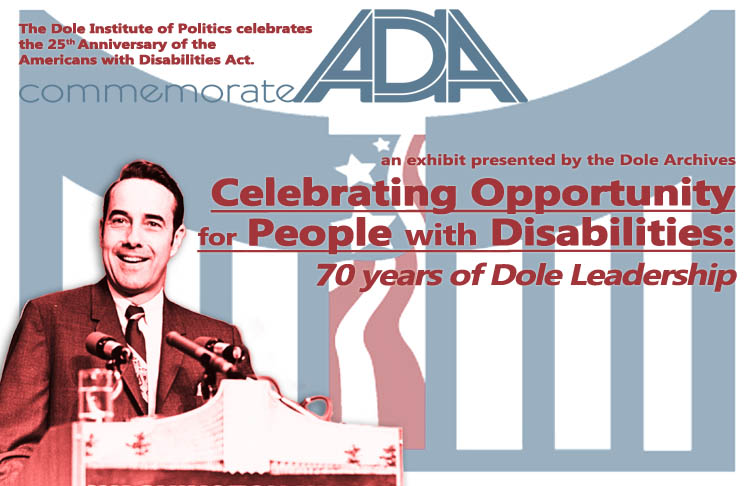
September 2015 - May 2016
The Dole Institute kicked off its 2015 commemorate ADA programming series on July 26, 2015, the 25th anniversary of the signing of the 1990 Americans with Disabilities Act, with an opening reception and program featuring the original Dole Archives exhibit, Celebrating Opportunity for People with Disabilities: 70 Years of Dole Leadership.
The exhibit, which shares stories of Bob Dole’s decades-long drive to make our nation a better place for all Americans, was produced by the staff of the Robert J. Dole Archive and Special Collections, with key contributions from Ray Mizumura-Pence, PhD, GE Curatorial Research Fellow, and many other campus and community collaborators.
The digital exhibit, featuring the full content of the physical installation, plus 12,000 pages of archival documents, full audio description provided by Kansas Audio Reader Network, and lesson plans for secondary schools, produced by KU Council for Social Studies, was the recipient of a 2015 Kansas Museums Association Technology Award.
2014
D.C. to DIOP: Connecting Collections
Summer 2014
Washington, D.C., and many other major cities around the United States, are home to some of the greatest museums in the world. Each of these museums contain important and valuable items in their collections, from presidential portraits, to an actual Air Force One jet. The Robert and Elizabeth Dole Archive and Special Collections is home to unexpected, noteworthy, and interesting items that relate to those that were presented in some of our national museums' own exhibits.
This exhibit showcases some of these interesting items. The National Portrait Gallery is featured for their collection of original artwork for some of Time magazine's covers. An edition from the 1960s is featured for their coverage of former Secretary of Agriculture Orville Freeman's 1964 National Wheat Referendum, and is accompanied by pamphlets and a letter from Senator Bob Dole discussing the program. The American Art Museum is featured for an exhibit showcasing contemporary artists who employ vivid imagery in the study of birds. A pane of stamps, image book on waterfowl, and a small desk sculpture from our archives accompany the exhibit. Finally, the National September 11 Memorial & Museum is featured, and showcases some of the initiatives that Senator Dole worked on in the wake of the attack.
2012 - 2013
Senator Daniel K. Inouye Memorial Exhibit
December 2012 - January 2013
While recovering from the wounds he sustained in World War II, a young Bob Dole met fellow patient Daniel Inouye at the Percy Jones Army Hospital. Inouye had been fighting not far from where Dole was in Italy, and sustained a severe wound to his right arm while fighting with retreating German forces. After his recovery, Inouye could no longer become a surgeon, as the loss of his right arm from his wounds impaired his ability to do so. Rather, he went back to college under the G.I. Bill, and earned degrees in political science and law. When Hawaii became the 50th State of the Union, Inouye was selected to serve as its first Congressman, later being elected to serve Hawaii in the United States Senate.
Even though Senators Dole and Inouye differed ideologically and philosophically, this exhibit looks at the evolution of their friendship, and how they were able to come together and find common ground on many issues. Because of this ethic, Inouye had the opportunity to serve on the Watergate Committee, the Special Committee on the Iran-Contra Affair, and many others.
2012
Senator George McGovern: A Lifetime Devoted to Ending Hunger
October - November 2012
After loosing a bid for the United States Senate in 1960, then-Congressman George McGovern was asked by President John F. Kennedy to lead the newly created Food for Peace program. The role gave him an opportunity to take action on much of what he had been an advocate for in the House of Representatives, ultimately leading the program to feed more than 10 million people in more than a dozen countries by the end of its first year in operation. He left the program in 1962 for another run for Senate, and took with him the idea of being able to use food as a driving force for economic development.
This memorial exhibit follows Senator McGovern's life, from his upbringing as a child during the Great Depression, to his military service as a pilot in World War II, and his service to the people of South Dakota in the United States Senate and House of Representatives. While in the Senate together and in their time after retirement, Senators George McGovern and Bob Dole worked together on many initiatives and pieces of legislation to better the lives of those in the United States, including food stamp reform, the World Food Programme, and the U.N. Food and Agriculture Organization.
2011
The Fall of the Soviet Union: 20 Years Later
Fall 2011
Dr. Herron is an Associate Professor in Political Science at KU and the former director of the Center for Russian, East European, and Eurasian Studies. He has traveled extensively in Eastern Europe and Eurasia, including a semester as a Fulbright scholar in Ukraine and nine election observation missions in Azerbaijan, Georgia, Moldova, Russia, and Ukraine. His photos and objects documenting election activities in former Soviet states were displayed in conjunction with programs at the Dole Institute during Fall 2011.
2010
Changing the Face of Power: Women in the U.S. Senate
June - July 2010
A captivating photography exhibit on the role of women serving in the U.S. Senate was displayed in the summer of 2010 at the Dole Institute of Politics at the University of Kansas.
The 38-photograph collection, titled “Changing the Face of Power: Women in the U.S. Senate,” documents the unprecedented role of women in the Senate, both behind-the-scenes and before the microphones. Photojournalist Melina Mara began the project in 2001, photographing the 13 women in the U.S. Senate. She continued through 2003, as their number grew to 14.
“There have only been 38 women in the entire history of the Senate, with 17 currently serving,” said Morgan Davis, senior archivist for the Dole Archive and Special Collections. “This exhibit highlights the growing influence of women in the Senate while also capturing the unique challenges they face.”
2009
"Lincoln Flag" display
February 2009
This original 34-star, Kansas Statehood, Civil War era flag, circa 1861-1963 was on display in the Reading Room of the Dole Institute through the month of February. The flag was on loan from KU Professor Emeritus Dennis Dailey.
The flag was known as the "Lincoln Flag" in part because Abraham Lincoln was the only president throughout the period it was used as the national flag, and because Lincoln would not allow any stars to be removed from the flag even though seven southern states were preparing to secede from the Union.
The flag was made of cotton muslin and is 11 feet long and 8 feet wide. The flag was machine stitched and is in good condition. The stitching is very tight, with fading consistent with age. The stars on the blue canton are in the “Staggered Star” pattern and are generally bright and fully intact, showing on both sides of the flag.
In the early 1970’s, the ends of the flag were professionally restored at the Valley Forge Flag Company in Valley Forge, Pennsylvania. On August 21, 2004 the flag was authenticated and appraised at the PBS Antiques Road Show in Portland, Oregon. The flag was likely flown at a military installation or on a large public building.
2008
You’ll Never Walk Alone: The Public and Private Life of Robert J. Dole
October - November 2008
From the age of 22, when he was deployed to Italy in World War II, Dole became a public figure, first locally and later nationwide. He learned early on to keep some parts of his life public and others private, which he continued to do throughout his highly publicized career. The exhibit explores the intersection between those private and public aspects, drawing on the resources of his archives at the Dole Institute.
Original papers, photographs, [and artifacts] will help tell the story by tracing important events in Dole’s life. Each of his experiences had an important impact on the decisions he made in Congress and the causes he supported. Visitors will learn about his long hospitalization after he was wounded in World War II, how an impoverished past led him to push for reforms in programs for low-income citizens and his continued work to benefit the disabled. New insights from Dole himself will help provide a complete look at his life.
Jamin Leigh Dreasher, a master’s degree student in museum studies at the University of Kansas and a former archival intern at the Dole Institute created the exhibit for the Institute as a traveling exhibit. The exhibit first opened in April of 2008 in Logan, Kansas at the Dane G. Hansen Museum.
2007 - 2008
Honor Flights
Every week, Senator Dole is at the World War II Memorial in Washington D.C., ready to greet fellow veterans from all over the country.
The veterans come by Honor Flight, a national program designed to give WWII soldiers a weekend to remember in Washington D.C. The entire trip is absolutely free and is funded through donations and volunteer efforts.
The program was started in 2003 by Earl Morse, a retired Air Force captain and a physician. He realized that for many of his patients, a trip to D.C. would have been financially and physically impossible without a program like Honor Flight. The program also serves terminally ill veterans of the Korean, Vietnam and Gulf wars, and plans to expand to serve all veterans.
2005
Leader of the Pack: Life as a Senate Leader
August - September 2005
This exhibit offers the public a glimpse into what daily life was like for Senator Dole. An anthropological exploration of sorts, this exhibit will display photographs and objects, including items removed from the Senator’s desk upon his retirement in 1996, which relate to Dole’s duties as a Senate leader, his obligations as a top member of the Republican Party, and various aspects of his personal life. Emphasized are his commitment to fair leadership and his dedication to public service.
The exhibit also includes publications of his daily schedules, never before viewed by the general public. The exhibit was designed and constructed by two of the Institute’s summer archival interns, Martina Smith and Emily Lowrance-Floyd, both graduate students at the University of Kansas.
2024 - 2025
ERA In the Heartland: Ratification and Reconsideration in Kansas, 1973-1980

June 2024 - Mar. 2025
In the early 1970s states raced to ratify the Equal Rights Amendment after it was passed in Congress. It seemed inevitable that the legislation, granting equal rights to men and women, would become the 27th amendment to the United States Constitution. Grassroots movements – for and against the amendment – mobilized swiftly in response. Highlighting the voices of ordinary Kansans, this exhibit explores the dialogue surrounding the adoption of the ERA in our state and its legacy today.
This exhibit is based on University of Kansas history and journalism student Alexandra Haggar’s Honors thesis: “Rescind ERA: The Failed Efforts in Kansas to Rescind Ratification of the Equal Rights Amendment, 1973-1980.”
This exhibit was presented in partnership with the KU Department of History and with special thanks to Dr. Marie Grace Brown.
This exhibit featured materials from the Kenneth Spencer Research Library at the University of Kansas.
2023 - 2024
Landmarks in Leadership: Bob Dole's Legacy at 100 Years

June 2023 - Mar. 2024
Senator Bob Dole’s leadership shaped Congress, our nation, and the world. See his life and legacy through your eyes by viewing our special exhibit, Landmarks in Leadership: Bob Dole’s Legacy at 100 Years.
To commemorate his 100th birthday, the Dole Archives presents never-displayed materials highlighting his landmark career. Featuring objects, manuscripts, and photographs from the Robert and Elizabeth Dole Archives and Special Collections, the exhibit tells the story of major moments in Senator Dole’s career through archival collections, such as a vintage 1968 Dole for Senate billboard, a scale model of the Dole Institute, and rocks used for the construction of the WWII Memorial in Washington, D.C.
Thank you to our Landmark Event Sponsors AARP-Kansas and Microsoft and all our season’s supporters.
2022 - 2023
Missing, Then Action: An Army Wife Speaks Out

June 2022 - May 2023
In June 1965, Kansan Kathleen Johnson received word that her husband, U.S. Army Major Bruce Johnson was missing.
For four years, she waited—then, she sought answers for her three young children. This is her story of love, loss, waiting – and action.
Kathleen Johnson of Salina, Kansas was a founding member of the National League of Families of Prisoners and Missing in Southeast Asia. These brave military wives from across the country spoke out, against government policy, to seek recognition, answers, and accounting for their prisoner of war (POW) and missing in action (MIA) husbands during Vietnam. Some national leaders, including Senator Bob Dole, became fervent advocates for them in the halls of the U.S. government.
This special exhibit is made possible by ITC Great Plains.
2022
What Would a Woman Offer Her Country? Elizabeth Dole's Ground-breaking, Trail-blazing Life of Service

March - May 2022
Featuring items from Elizabeth Dole’s own historical collections, which she donated to the Dole Institute in 2017, the exhibit chronicles over 6 decades of people-focused leadership and policymaking.
2021
Voices from the Big First, 1961-1968

February - October 2021
In 1961, Kansas, with the rest of the United States, found itself at a political, social, and cultural crossroads. Featuring a selection of constituent letters written to then-Congressman Bob Dole from the collections of the Dole Archives, this original exhibit offers a window into the hopes and fears of everyday Kansans as they responded to change at home and conflict abroad.
Visit the companion 'Voices from the Big First, 1961-1968' digital exhibit
September 11, 2001: The Day that Changed the World
August - September 2021
The Dole Institute displayed a special poster exhibition in Simons Media Room from August 31 through September 19, on the occasion of the 20th anniversary of the September 11 attacks. Entitled “September 11, 2001: The Day that Changed the World,” the exhibit reviews the events of the day, highlights personal experiences, and invites reflection. It was developed by the 9/11 Memorial Museum with support from the National Endowment for the Humanities.
In Hansen Hall, visitors can also view two original beams from World Trade Center Tower One, a permanent memorial at the Institute. The two columns were salvaged and presented to the Dole Institute by Mayor Michael Bloomberg, in appreciation of Senator Bob Dole’s work with Former President Bill Clinton on the Families of Freedom Scholarship Fund for the children of 9/11 victims.
2019 - 2020
What Would a Woman Offer Her Country? Elizabeth Dole’s Ground-breaking, Trail-blazing Life of Service
December 2019 - May 2020
In her 1999 exploratory announcement for her presidential campaign, Senator Elizabeth Dole asked, "What would I as a woman offer our country?" The answer can be seen throughout her years of public service, where she served as the head of some of our government's most important offices, including the Department of Transportation, the Department of Labor, and the Federal Trade Commission. She also served as head of the American Red Cross, where she played an important role in the United States' efforts aid those who were impacted by disasters around the world.
Charting her over six decades of people-focused leadership and policymaking, the exhibit features over 100 items from Dole’s own historical collections, which Elizabeth Dole donated to the Dole Institute in 2017. Special emphasis is given to her time in the federal bureaucracy, while also highlighting her service to the people of North Carolina in the United States Senate, and her attempt for the presidency in 2000.
2019
Inspired by Ike

June - August 2019
Senator Bob Dole’s admiration for President Dwight D. Eisenhower shines in his historical collections at the Dole Institute. As a fellow Kansan and a soldier in World War II, Bob Dole was inspired by the leadership of his commanding officer, General Eisenhower. Years later, President Eisenhower’s messages of people and principle attracted political aspirant Dole to the Republican Party. In the decades after the President’s death, Dole lead many efforts to honor his political hero, including serving as the Chairman of the 1990 Dwight David Eisenhower Centennial Commission, and as finance chair for the Campaign for the Eisenhower Memorial.
This collection feature at the Dole Institute explores photos, historical mementos and documents from the archives that trace Dole’s lifelong admiration for Eisenhower. This feature marks the 75th anniversary of D-Day, and celebrates the re-opening of the renovated Dwight D. Eisenhower Presidential Library in Abilene, Kansas.
2017
The League of Wives: Vietnam’s POW/MIA Allies & Advocates

May - December 2017
In the late 1960s, POW/MIA wives bucked government protocol and challenged the traditional role of “military wife.” These courageous women led by Sybil Stockdale on the West Coast, Jane Denton, Louise Mulligan, and Phyllis Galanti on the East Coast and later Helene Knapp in the Interior West organized to form the National League of POW/MIA Families. The women worked with Congress and the Nixon administration to demand accounting for their husbands and pursue their safe return after years of imprisonment and torture by the North Vietnamese.
Curated by 2017 Dole Archives Curatorial Fellow Heath Hardage Lee, and based on her upcoming book, The League of Wives: a True Story of Survival and Rescue from the Homefront (2019, St. Martin’s Press), this special exhibition features documents, photos, oral histories and memorabilia from the Dole Archives, personal collections of POW/MIA families, and other institutions.
Programming made possible by funding from Harlan and Alice Ann Ochs, of Colorado Springs, in honor of Larry Ochs.
2016 - 2017
From State to Nation: Dole for Vice President, 1976

August 2016 - January 2017
The 1976 presidential campaign came to fruition under extraordinary circumstances. The nation was celebrating its 200th birthday, while also reeling from the betrayal and resignation of President Richard Nixon in the wake of the 1974 Watergate scandal. Then-Vice President Gerald Ford assumed the duties of president, and faced his first attempt to run for the presidency in 1976 - an unusual situation for a sitting president. But President Ford faced varying challenges in his candidacy, including the rise of California Governor Ronald Reagan, and the announcement that his Vice President, Nelson Rockefeller, would not join President Ford on the ballot.
The exhibit follows the path that brought Kansas' junior senator, Bob Dole, to being selected as President Ford's running mate. Dole's experience as the Chairman of the Republican National Committee and in the Senate gave proof to his loyalty to the Republican Party. These conservative credentials, along with his Midwestern appeal, skill in retail politics, and aggressive campaign style, contributed to Ford's selection of him for the Vice Presidency.
See the related oral history digital exhibit, Legacies of '76, which showcases many of the materials from the Robert and Elizabeth Dole Archives and Special Collections that relate to the Ford-Dole 1976 Campaign for President.
Audio description for this exhibit made possible by Kansas Audio-Reader Network - Made possible by the Enid and Crosby Kemper Foundation
2015 - 2016
Celebrating Opportunity for People with Disabilities: 70 Years of Dole Leadership

September 2015 - May 2016
The Dole Institute kicked off its 2015 commemorate ADA programming series on July 26, 2015, the 25th anniversary of the signing of the 1990 Americans with Disabilities Act, with an opening reception and program featuring the original Dole Archives exhibit, Celebrating Opportunity for People with Disabilities: 70 Years of Dole Leadership.
The exhibit, which shares stories of Bob Dole’s decades-long drive to make our nation a better place for all Americans, was produced by the staff of the Robert J. Dole Archive and Special Collections, with key contributions from Ray Mizumura-Pence, PhD, GE Curatorial Research Fellow, and many other campus and community collaborators.
The digital exhibit, featuring the full content of the physical installation, plus 12,000 pages of archival documents, full audio description provided by Kansas Audio Reader Network, and lesson plans for secondary schools, produced by KU Council for Social Studies, was the recipient of a 2015 Kansas Museums Association Technology Award.
2014
D.C. to DIOP: Connecting Collections
Summer 2014
Washington, D.C., and many other major cities around the United States, are home to some of the greatest museums in the world. Each of these museums contain important and valuable items in their collections, from presidential portraits, to an actual Air Force One jet. The Robert and Elizabeth Dole Archive and Special Collections is home to unexpected, noteworthy, and interesting items that relate to those that were presented in some of our national museums' own exhibits.
This exhibit showcases some of these interesting items. The National Portrait Gallery is featured for their collection of original artwork for some of Time magazine's covers. An edition from the 1960s is featured for their coverage of former Secretary of Agriculture Orville Freeman's 1964 National Wheat Referendum, and is accompanied by pamphlets and a letter from Senator Bob Dole discussing the program. The American Art Museum is featured for an exhibit showcasing contemporary artists who employ vivid imagery in the study of birds. A pane of stamps, image book on waterfowl, and a small desk sculpture from our archives accompany the exhibit. Finally, the National September 11 Memorial & Museum is featured, and showcases some of the initiatives that Senator Dole worked on in the wake of the attack.
2012 - 2013
Senator Daniel K. Inouye Memorial Exhibit
December 2012 - January 2013
While recovering from the wounds he sustained in World War II, a young Bob Dole met fellow patient Daniel Inouye at the Percy Jones Army Hospital. Inouye had been fighting not far from where Dole was in Italy, and sustained a severe wound to his right arm while fighting with retreating German forces. After his recovery, Inouye could no longer become a surgeon, as the loss of his right arm from his wounds impaired his ability to do so. Rather, he went back to college under the G.I. Bill, and earned degrees in political science and law. When Hawaii became the 50th State of the Union, Inouye was selected to serve as its first Congressman, later being elected to serve Hawaii in the United States Senate.
Even though Senators Dole and Inouye differed ideologically and philosophically, this exhibit looks at the evolution of their friendship, and how they were able to come together and find common ground on many issues. Because of this ethic, Inouye had the opportunity to serve on the Watergate Committee, the Special Committee on the Iran-Contra Affair, and many others.
2012
Senator George McGovern: A Lifetime Devoted to Ending Hunger
October - November 2012
After loosing a bid for the United States Senate in 1960, then-Congressman George McGovern was asked by President John F. Kennedy to lead the newly created Food for Peace program. The role gave him an opportunity to take action on much of what he had been an advocate for in the House of Representatives, ultimately leading the program to feed more than 10 million people in more than a dozen countries by the end of its first year in operation. He left the program in 1962 for another run for Senate, and took with him the idea of being able to use food as a driving force for economic development.
This memorial exhibit follows Senator McGovern's life, from his upbringing as a child during the Great Depression, to his military service as a pilot in World War II, and his service to the people of South Dakota in the United States Senate and House of Representatives. While in the Senate together and in their time after retirement, Senators George McGovern and Bob Dole worked together on many initiatives and pieces of legislation to better the lives of those in the United States, including food stamp reform, the World Food Programme, and the U.N. Food and Agriculture Organization.
2011
The Fall of the Soviet Union: 20 Years Later
Fall 2011
Dr. Herron is an Associate Professor in Political Science at KU and the former director of the Center for Russian, East European, and Eurasian Studies. He has traveled extensively in Eastern Europe and Eurasia, including a semester as a Fulbright scholar in Ukraine and nine election observation missions in Azerbaijan, Georgia, Moldova, Russia, and Ukraine. His photos and objects documenting election activities in former Soviet states were displayed in conjunction with programs at the Dole Institute during Fall 2011.
2010
Changing the Face of Power: Women in the U.S. Senate
June - July 2010
A captivating photography exhibit on the role of women serving in the U.S. Senate was displayed in the summer of 2010 at the Dole Institute of Politics at the University of Kansas.
The 38-photograph collection, titled “Changing the Face of Power: Women in the U.S. Senate,” documents the unprecedented role of women in the Senate, both behind-the-scenes and before the microphones. Photojournalist Melina Mara began the project in 2001, photographing the 13 women in the U.S. Senate. She continued through 2003, as their number grew to 14.
“There have only been 38 women in the entire history of the Senate, with 17 currently serving,” said Morgan Davis, senior archivist for the Dole Archive and Special Collections. “This exhibit highlights the growing influence of women in the Senate while also capturing the unique challenges they face.”
2009
"Lincoln Flag" display
February 2009
This original 34-star, Kansas Statehood, Civil War era flag, circa 1861-1963 was on display in the Reading Room of the Dole Institute through the month of February. The flag was on loan from KU Professor Emeritus Dennis Dailey.
The flag was known as the "Lincoln Flag" in part because Abraham Lincoln was the only president throughout the period it was used as the national flag, and because Lincoln would not allow any stars to be removed from the flag even though seven southern states were preparing to secede from the Union.
The flag was made of cotton muslin and is 11 feet long and 8 feet wide. The flag was machine stitched and is in good condition. The stitching is very tight, with fading consistent with age. The stars on the blue canton are in the “Staggered Star” pattern and are generally bright and fully intact, showing on both sides of the flag.
In the early 1970’s, the ends of the flag were professionally restored at the Valley Forge Flag Company in Valley Forge, Pennsylvania. On August 21, 2004 the flag was authenticated and appraised at the PBS Antiques Road Show in Portland, Oregon. The flag was likely flown at a military installation or on a large public building.
2008
You’ll Never Walk Alone: The Public and Private Life of Robert J. Dole
October - November 2008
From the age of 22, when he was deployed to Italy in World War II, Dole became a public figure, first locally and later nationwide. He learned early on to keep some parts of his life public and others private, which he continued to do throughout his highly publicized career. The exhibit explores the intersection between those private and public aspects, drawing on the resources of his archives at the Dole Institute.
Original papers, photographs, [and artifacts] will help tell the story by tracing important events in Dole’s life. Each of his experiences had an important impact on the decisions he made in Congress and the causes he supported. Visitors will learn about his long hospitalization after he was wounded in World War II, how an impoverished past led him to push for reforms in programs for low-income citizens and his continued work to benefit the disabled. New insights from Dole himself will help provide a complete look at his life.
Jamin Leigh Dreasher, a master’s degree student in museum studies at the University of Kansas and a former archival intern at the Dole Institute created the exhibit for the Institute as a traveling exhibit. The exhibit first opened in April of 2008 in Logan, Kansas at the Dane G. Hansen Museum.
2007 - 2008
Honor Flights
Every week, Senator Dole is at the World War II Memorial in Washington D.C., ready to greet fellow veterans from all over the country.
The veterans come by Honor Flight, a national program designed to give WWII soldiers a weekend to remember in Washington D.C. The entire trip is absolutely free and is funded through donations and volunteer efforts.
The program was started in 2003 by Earl Morse, a retired Air Force captain and a physician. He realized that for many of his patients, a trip to D.C. would have been financially and physically impossible without a program like Honor Flight. The program also serves terminally ill veterans of the Korean, Vietnam and Gulf wars, and plans to expand to serve all veterans.
2005
Leader of the Pack: Life as a Senate Leader
August - September 2005
This exhibit offers the public a glimpse into what daily life was like for Senator Dole. An anthropological exploration of sorts, this exhibit will display photographs and objects, including items removed from the Senator’s desk upon his retirement in 1996, which relate to Dole’s duties as a Senate leader, his obligations as a top member of the Republican Party, and various aspects of his personal life. Emphasized are his commitment to fair leadership and his dedication to public service.
The exhibit also includes publications of his daily schedules, never before viewed by the general public. The exhibit was designed and constructed by two of the Institute’s summer archival interns, Martina Smith and Emily Lowrance-Floyd, both graduate students at the University of Kansas.